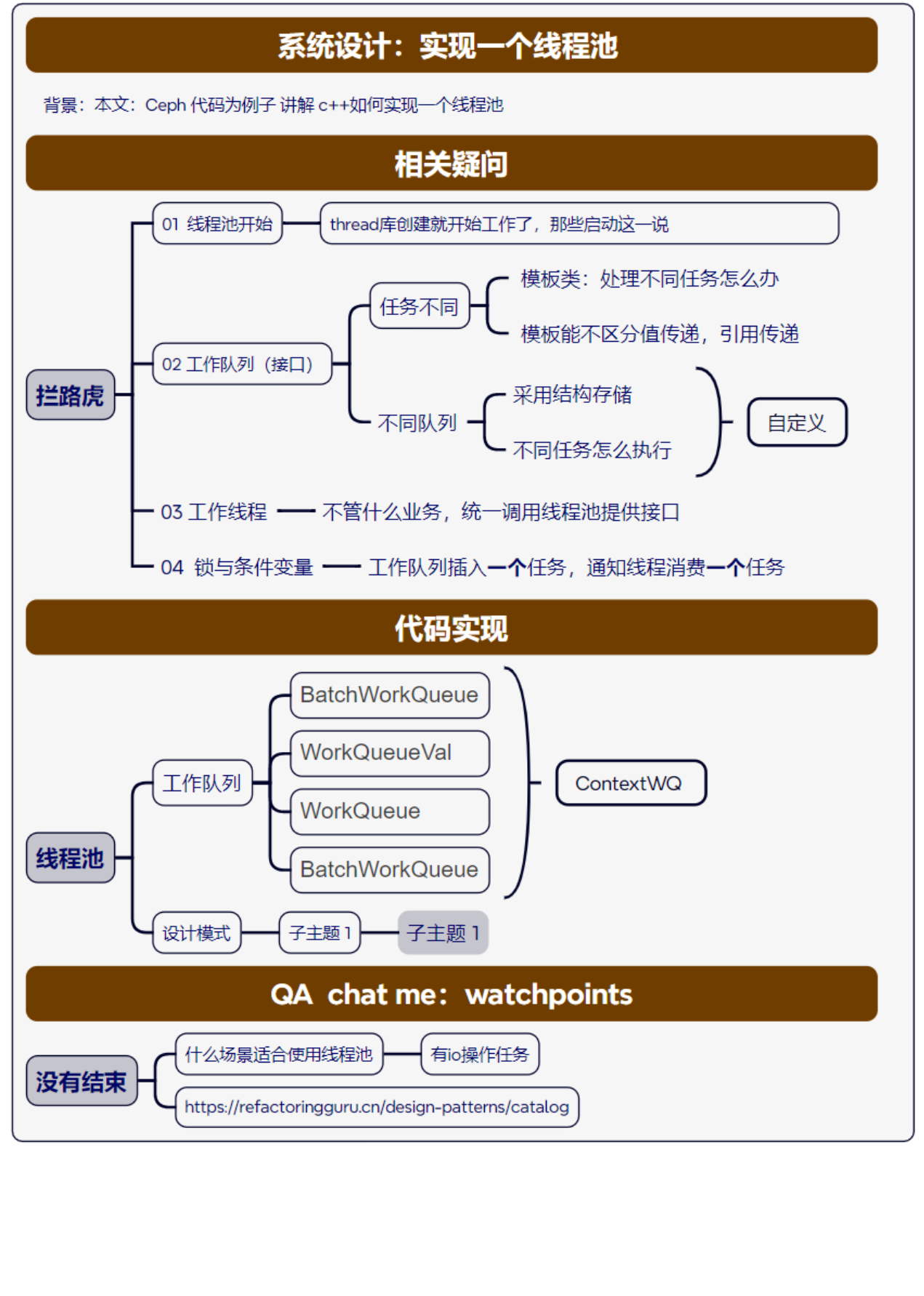【注意】最后更新于 March 3, 2024,文中内容可能已过时,请谨慎使用。
/Users/wangchuanyi/doc/daily-interview/blog

在温和的春夜里,路灯投下淡淡的黄光,小王沿着柳树成荫的街道散步,思绪随着微风轻轻飘散。不远处,他的邻居老王也正慢慢踱步,一如既往地享受着夜的安宁。
“晚上好,老王!”小王热情地打招呼。
老王抬头,嘴角上扬,开心地回应:“晚上好,小王。夜晚散步,别有一番风味啊。”
两人自然地并肩走着,闲聊起邻里间的琐事和生活的点点滴滴。随着对话的深入,
小王提问: 来我熟记了各种线程池把八股文 为什么,还是不行
老王回答: 从基本的一个调用开始,亲自用一下,观察你发现什么问题
我来演示一下基本用法
1
2
3
4
5
6
7
8
9
10
11
12
13
14
15
16
17
18
19
20
21
22
23
24
25
26
27
28
29
30
31
32
33
34
35
|
BlueStore.cc (src\os\bluestore) line 8472 : class ShallowFSCKThreadPool : public ThreadPool
const size_t thread_count = cct->_conf->bluestore_fsck_quick_fix_threads;
//定义工作队列
typedef ShallowFSCKThreadPool::FSCKWorkQueue<256> WQ;
std::unique_ptr<WQ> wq(
new WQ(
"FSCKWorkQueue",
(thread_count ? : 1) * 32,
this,
sb_info_lock,
sb_info,
sb_ref_counts,
repairer));
//定义一个线程池,指定线程个数thread_count
ShallowFSCKThreadPool thread_pool(cct, "ShallowFSCKThreadPool", "ShallowFSCK", thread_count);
//定义线程池的工作队列,这个例子工作队列放在外面
thread_pool.add_work_queue(wq.get());
if (depth == FSCK_SHALLOW && thread_count > 0) {
//not the best place but let's check anyway
ceph_assert(sb_info_lock);
thread_pool.start();
}
class ShallowFSCKThreadPool : public ThreadPool
{
public:
ShallowFSCKThreadPool(CephContext* cct_, std::string nm, std::string tn, int n) :
ThreadPool(cct_, nm, tn, n) {
}
template <size_t BatchLen>
struct FSCKWorkQueue : public ThreadPool::WorkQueue_
|
我在来演示一个例子
1
2
3
4
5
6
7
8
9
10
11
12
13
14
15
16
17
18
19
20
21
22
23
24
25
26
27
28
29
30
31
32
33
34
35
36
37
38
39
40
41
42
43
44
45
46
47
48
49
50
51
52
53
54
55
56
57
58
59
60
|
// ThreadPoolSingleton是一个继承自ThreadPool的单例类
class ThreadPoolSingleton : public ThreadPool {
public:
// 显式的构造函数,构造时会初始化父类ThreadPool并启动线程池
explicit ThreadPoolSingleton(CephContext *cct)
: ThreadPool(cct, "librbd::ImageUpdateWatchers::thread_pool", "tp_librbd",
1) {
start(); // 调用ThreadPool的start方法启动线程池
}
// 重写的析构函数,销毁对象时停止线程池
~ThreadPoolSingleton() override {
stop(); // 调用ThreadPool的stop方法停止线程池
}
};
// 声明一个指向ContextWQ类型(工作队列)的指针,默认初始化为nullptr
ContextWQ *m_work_queue = nullptr;
// 创建一个工作队列的方法
void create_work_queue() {
if (m_work_queue != nullptr) {
return; // 如果工作队列已经存在,则不做任何操作
}
// 查找或者创建一个ThreadPoolSingleton类型的单例对象作为线程池
auto& thread_pool = m_cct->lookup_or_create_singleton_object<
ThreadPoolSingleton>("librbd::ImageUpdateWatchers::thread_pool",
false, m_cct);
// 创建一个新的ContextWQ对象作为工作队列,并使用配置中定义的操作线程超时设置
m_work_queue = new ContextWQ("librbd::ImageUpdateWatchers::work_queue",
ceph::make_timespan(
m_cct->_conf.get_val<uint64_t>("rbd_op_thread_timeout")),
&thread_pool);
}
// 销毁工作队列的方法
void destroy_work_queue() {
if (m_work_queue == nullptr) {
return; // 如果工作队列不存在,则不做任何操作
}
m_work_queue->drain(); // 清空工作队列
delete m_work_queue; // 删除工作队列对象
}
// 定义一个函数send_notify,用于发送通知
// handle是要通知的句柄,watcher是更新监视器的上下文
void send_notify(uint64_t handle, UpdateWatchCtx *watcher) {
// 创建一个新的LambdaContext对象,该对象封装了一个lambda表达式
// 当调度给定的Context时,lambda表达式将被调用
Context *ctx = new LambdaContext(
[this, handle, watcher](int r) { // lambda捕获this指针、handle和watcher
handle_notify(handle, watcher); // 在lambda内部调用handle_notify函数处理通知
});
m_work_queue->queue(ctx, 0); // 将新创建的LambdaContext对象添加到工作队列中,准备执行
}
创建了一个 LambdaContext 对象,这个对象接收一个 lambda 表达式,用于异步执行完成通知的操作。
最终,通过 queue 方法将这个上下文添加到工作队列中以便执行。
这里 lambda 表达式捕获了 this 指针、handle和watcher的值,并在后台线程中调用 handle_notify 函数。
|
小王提问:我看到都是继承,里面有工作队列和放入任务,怎么被线程调用呢
老王回答:线程池 统一提供接口
1.3 线程池的执行函数
函数worker为线程池的执行函数:
voidThreadPool::worker(WorkThread *wt)
其处理过程如下:
1)首先检查_stop标志,确保线程池没有关闭。
2)调用函数join_old_threads把旧的工作线程释放掉。检查如果线程数量大于配置的数量_num_threads,就把当前线程从线程集合中删除,并加入_old_threads队列中,并退出循环。
3)如果线程池没有暂时中止,并且work_queues不为空,就从last_work_queue开始,遍历每一个工作队列,如果工作队列不为空,就取出一个item,调用工作队列的处理函数做处理。
小王提问:工作队列 为什么还是继承,难道任务 处理,存储 可以采用不同形式?
老王回答:虚基类 WorkQueue 提供了结构 根据不同需求,采取不同结构
虚基类 WorkQueue_
1
2
3
4
5
6
7
8
9
10
11
12
13
14
15
16
17
18
19
20
21
22
23
|
struct WorkQueue_ {
std::string name;
time_t timeout_interval, suicide_interval;
WorkQueue_(std::string n, time_t ti, time_t sti)
: name(std::move(n)), timeout_interval(ti), suicide_interval(sti)
{ }
virtual ~WorkQueue_() {}
/// Remove all work items from the queue.
virtual void _clear() = 0;
/// Check whether there is anything to do.
virtual bool _empty() = 0;
/// Get the next work item to process.
virtual void *_void_dequeue() = 0; //取出待处理的items
/** @brief Process the work item.
* This function will be called several times in parallel
* and must therefore be thread-safe. */
virtual void _void_process(void *item, TPHandle &handle) = 0;
/** @brief Synchronously finish processing a work item.
* This function is called after _void_process with the global thread pool lock held,
* so at most one copy will execute simultaneously for a given thread pool.
* It can be used for non-thread-safe finalization. */
virtual void _void_process_finish(void *) = 0;
};
|
四类 work_queue
- BatchWorkQueue
- 每次可以取出多个待处理item
- 该WorkQueued的item存放容器需要自行定义
- 需要自行实现如下接口(主要函数):
virtual void _dequeue(std::list<T*> *) = 0: 如何从队列中work_queue中拿出itemsvirtual bool _enqueue(T *) = 0: 入队列接口virtual void _process(const std::list<T*> &items, TPHandle &handle) = 0: 批处理接口
- WorkQueueVal
- 适用于处理原始值类型或者小对象
- 将T类型item的值存储队列
- 存储T类型值的容器需要自行实现
- 处理缓存容器已经实现,用于存在中间值:
- std::list to_process; //待处理list, 从放入_void_dequeue()拿出的元素U,每次存入一个
- std::list to_finish; //_void_process_finish会处理该list中的元素,每次处理一个
- 需要自行实现如下接口:
bool _empty() override = 0: 判断容器非空virtual void _enqueue(T) = 0;: 入队列接口virtual void _process(U u, TPHandle &) = 0;: 处理元素U的函数
- WorkQueue
- 适用于处理大对象或者动态申请内存的对象
- 存储容器需要自行实现
- 需要自行实现如下接口:
virtual bool _enqueue(T *) = 0;: 入workqueue接口virtual T *_dequeue() = 0;: 取work_queue item接口virtual void _process(T *t, TPHandle &) = 0; : item处理接口
- PointerWQ
- 适用于处理大对象或者动态申请内存的对象,比WorkQueue更加方便,但是没有WorkQueue抽象
- 存储容器已经实现:
std::list<T *> m_items
- 只需要实现
virtual void process(T *item) = 0;, 用于item处理
可直接使用的两种实现
1
2
3
4
5
6
7
8
9
10
11
12
13
14
|
class New_WQ : public ThreadPool::PointerWQ<Context>
{
public:
New_WQ(const std::string &name, time_t ti, ThreadPool *tp)
: ThreadPool::PointerWQ<Context>(name, ti, 0, tp) {
this->register_work_queue();
}
void process(Context *fin) override;
};
void New_WQ::process(Context *fin)
{
fin->complete(0);
}
|
1
2
3
4
5
6
|
1. 创建ThreadPool
thread_pool = new ThreadPool(cct, "thread_pool", "daemon_tp", g_conf()->rep_thread_pool_nr);
thread_pool->start();
2. 创建队列
work_queue = new New_WQ("daemon", 60, thread_pool);
|
1
2
|
Context *ctx = new Test_TheadPool();
work_queue->queue(ctx);
|
学习方法
1
2
3
4
5
6
7
8
9
10
11
12
|
一、这个技术出现的背景、初衷和要达到什么样的目标或是要解决什么样的问题
二、这个技术的优势和劣势分别是什么
三、这个技术适用的场景。任何技术都有其适用的场景,离开了这个场景
四、技术的组成部分和关键点。
五、技术的底层原理和关键实现
六、已有的实现和它之间的对比
|

